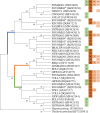Untangling the actual infection status: detection of avian haemosporidian parasites of three Malagasy bird species using microscopy, multiplex PCR, and nested PCR methods
- PMID: 35939148
- PMCID: PMC9464167
- DOI: 10.1007/s00436-022-07606-4
Untangling the actual infection status: detection of avian haemosporidian parasites of three Malagasy bird species using microscopy, multiplex PCR, and nested PCR methods
Abstract
The development of new molecular methods has significantly improved the detection and identification of avian haemosporidian parasites (Plasmodium, Haemoproteus and Leucocytozoon) compared to microscopic examination. Very large numbers of previously hidden Haemosporida species of a wide range of avian hosts have thus been discovered in the last two decades. However, test parameters of the various detection methods remain largely unevaluated. In this study, the merits of microscopy, multiplex PCR, and nested PCR were compared to identify the infection status of three Malagasy bird species. A total of 414 blood samples of Hypsipetes madagascariensis, Foudia omissa and F. madagascariensis, as well as 147 blood smears, were examined for haemosporidian infection. Thirty-four lineages of haemosporidian parasites could be identified, of which six have been detected for the first time. Microscopy, multiplex and nested PCR showed differences in detection rate, most likely due to low parasitemia of chronically infected birds. The combination of both PCR methods yielded the best results. In particular, detection of multiple infections could be greatly improved and will enable more precise prevalence estimates of individual haemosporidian species in wild birds in the future.
Keywords: Haemoproteus; Leucocytozoon; Mixed infection; Parasite detection; Plasmodium.
© 2022. The Author(s).
Conflict of interest statement
The authors declare no competing interests.
Figures






Similar articles
-
A new one-step multiplex PCR assay for simultaneous detection and identification of avian haemosporidian parasites.Parasitol Res. 2019 Jan;118(1):191-201. doi: 10.1007/s00436-018-6153-7. Epub 2018 Dec 7. Parasitol Res. 2019. PMID: 30536121
-
Prevalence and genetic diversity of avian haemosporidian parasites in wild bird species of the order Columbiformes.Parasitol Res. 2021 Apr;120(4):1405-1420. doi: 10.1007/s00436-021-07053-7. Epub 2021 Feb 1. Parasitol Res. 2021. PMID: 33521839 Free PMC article.
-
A novel one-step multiplex PCR protocol to detect avian haemosporidian parasites in the subgenus Haemoproteus (Kruse, 1890) used to quantify parasite prevalence in domestic pigeons (Columba livia) in Turkey.Vet Res Commun. 2023 Jun;47(2):511-521. doi: 10.1007/s11259-022-09962-z. Epub 2022 Jun 23. Vet Res Commun. 2023. PMID: 35739341
-
Exo-erythrocytic development of avian malaria and related haemosporidian parasites.Malar J. 2017 Mar 3;16(1):101. doi: 10.1186/s12936-017-1746-7. Malar J. 2017. PMID: 28253926 Free PMC article. Review.
-
Diptera vectors of avian Haemosporidian parasites: untangling parasite life cycles and their taxonomy.Biol Rev Camb Philos Soc. 2012 Nov;87(4):928-64. doi: 10.1111/j.1469-185X.2012.00234.x. Epub 2012 May 23. Biol Rev Camb Philos Soc. 2012. PMID: 22616880 Review.
Cited by
-
Insights into the Biology of Leucocytozoon Species (Haemosporida, Leucocytozoidae): Why Is There Slow Research Progress on Agents of Leucocytozoonosis?Microorganisms. 2023 May 9;11(5):1251. doi: 10.3390/microorganisms11051251. Microorganisms. 2023. PMID: 37317225 Free PMC article. Review.
-
Haemosporidian parasite infections of Malagasy Philepittidae and Nectariniidae are driven by phylogeny rather than ecology.Parasitology. 2023 Dec;150(14):1316-1329. doi: 10.1017/S0031182023001075. Epub 2023 Nov 10. Parasitology. 2023. PMID: 38087861 Free PMC article.
-
Raising the bar: genus-specific nested PCR improves detection and lineage identification of avian haemosporidian parasites.Front Cell Infect Microbiol. 2024 Apr 29;14:1385599. doi: 10.3389/fcimb.2024.1385599. eCollection 2024. Front Cell Infect Microbiol. 2024. PMID: 38741893 Free PMC article.
-
Mitochondrial genome amplification of avian haemosporidian parasites from single-infected wildlife samples using a novel nested PCR approach.Parasitol Res. 2023 Dec;122(12):2967-2975. doi: 10.1007/s00436-023-07986-1. Epub 2023 Oct 3. Parasitol Res. 2023. PMID: 37787788 Free PMC article.
-
Haemosporidian Parasites of White-Breasted Waterhens (Amaurornis phoenicurus), with a Report and Molecular Characterization of Haemoproteus gallinulae in Thailand.Animals (Basel). 2023 Jun 16;13(12):2006. doi: 10.3390/ani13122006. Animals (Basel). 2023. PMID: 37370516 Free PMC article.
References
-
- Asghar M, Hasselquist D, Bensch S. Are chronic avian haemosporidian infections costly in wild birds? J Avian Biol. 2011;42:530–537. doi: 10.1111/j.1600-048X.2011.05281.x. - DOI
-
- Bennett GF, Earlé RA, Peirce MA, et al. Avian Leucocytozoidae: the leucocytozoids of the Phasianidae sensu lato. J Nat Hist. 1991;25:1407–1428. doi: 10.1080/00222939100770891. - DOI
MeSH terms
Substances
Grants and funding
LinkOut - more resources
Full Text Sources

